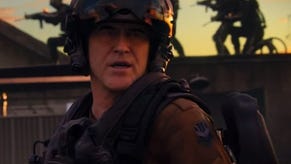Face-Off: Call of Duty: Advanced Warfare
Sledgehammer's next-gen engine assessed across PS4, Xbox One and PC.
It's still Call of Duty, but how fine it looks. On all formats, Advanced Warfare brings the generational leap we wished we had seen in Ghosts - one that benefits not only PS4 and Xbox One versions but also the maxed-out PC release. Post-processing ingenuity, a rebuilt lighting model, plus the use of best-in-class motion-capture tech make this the most photo-realistic entry yet. But while each version has its advantages, exactly what improvements does PC itself bring to the table and what hardware does it take to run?
First off, let's address some unfinished business on console; namely the resolution issue. For campaign only, a majority of the gun-toting action runs at 1360x1080 on Xbox One, while PS4 charges in with a full 1920x1080. However, courtesy of a dynamic frame-buffer, there are specific areas designed to render at a full, true 1080p on Xbox One - given the head-room. For example, the interior of a besieged Atlas control room runs at this lower rate in the Fission stage, while the bus-hopping set-piece, closing the Nigeria level, runs at the full value.
The transition itself is never obvious. But after sampling as many static shots we could find, we've yet to encounter any horizontal pixel-counts in between 1360 and 1920. Advanced Warfare may briefly flick past intermediate numbers, but in practice the game is mostly rendered at one of these two resolutions; the higher mode kicking in when it can be afforded. It's unlike the dynamic model as seen in the likes of Rage or Wipeout HD - where pixel counts scale across a range of middle values based on the on-screen action.
For Xbox One's multiplayer, the scenario is different. The 1360x1080 resolution is a stuck fixture in this mode, with the 1920x1080 pixel boost simply never kicking in as it does in campaign - even playing on small maps. Having tested all 13 available stages, the result is always the same; Xbox One sports a blurrier presentation than PS4's, particularly across distant textures and transparency effects. Added to that, the cut-down post-processing effects for multiplayer, such as motion blur, makes the gap in console resolutions easier to catch in competitive modes.
Alternative comparisons:
Through our like-for-like captures of PC, PS4 and Xbox One, we're able to see how image quality holds up in campaign mode across all three. The PC release is replete with modes to tackle aliasing, including FXAA, a SMAA setting that cranks up to T2X, and a 'filmic' variant of SMAA that changes its effective threshold when in motion. As a costly alternative, we have the option of super sampling too - where much higher resolutions are downscaled to the display output, reserved for cards with high memory bandwidths. For our tests, we opt for a mixture; 2x SSAA and also SMAA T2X for strong, all-round coverage of each frame, while both PS4 and Xbox One appear to utilise the lesser FXAA post processing.
With so many post-processing effects on the go, it's a challenge to pick out many visual contrasts. The Xbox One's deficit in pixel-count is, to start, far less apparent in campaign as a result of this deluge of effects - unlike the state of affairs in multiplayer. However, on its default brightness setting (matched at 3.3 notches with the PS4 and PC), we notice a native black crush affecting visibility in dark areas. It can be rectified, to an extent, by cranking the in-game brightness up by four points in Advanced Warfare's menu, but the image begins to wash out if we go any further. Not ideal. In our initial campaign performance analysis, we found an area where PS4 has pared back shadows - however, this appears to be a one-off, with every other comparison demonstrating parity in this area.
On PC, we're handed a bevy of graphics options to tinker with. At the top, we get a field of view (FOV) selector, affording us a range between 60 and 90 - where consoles are fixed at a strict 65 degrees. However, in the interest of framing cut-scenes correctly in campaign mode, the PC is fixed at this console value, with no official means to broaden it.

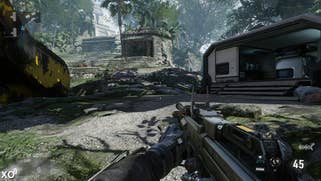






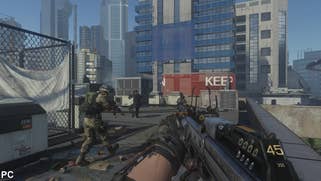

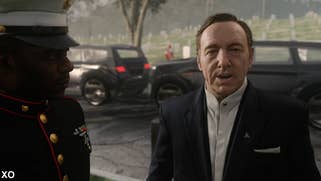
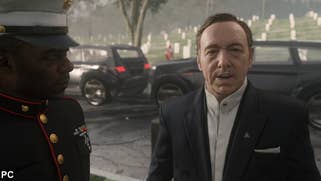
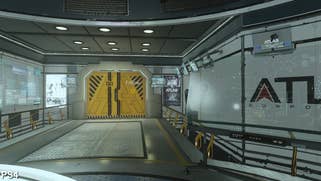



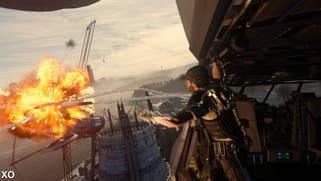

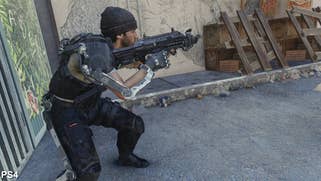
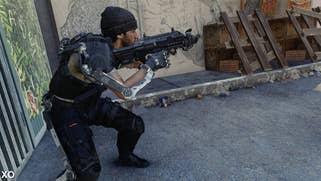
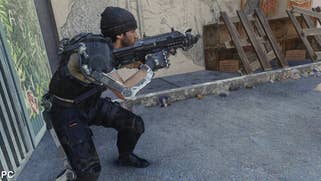
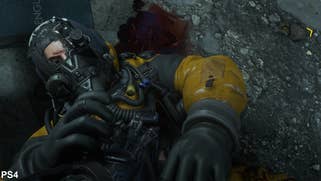
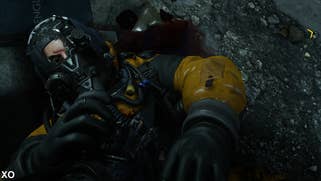
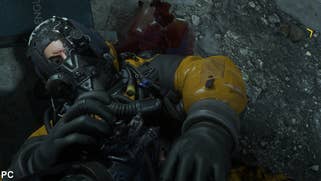
Surprisingly, the console versions rank closely next to the PC at max, but miss out on a few visual treats. Looking at the graphics settings, texture and normal map options are present, where the PS4 and Xbox One impressively match the highest extra setting PC has to offer. However, for the interiors of Atlas' labs, specular mapping runs at one notch lower on console, producing less defined spotlight reflections across its glossy floors.
Frustratingly, while console texture quality runs at this premium grade, the anisotropic filtering backing it up is set to an equivalent of PC's low setting. As a result, we get an obvious blurring to angled surfaces just a few metres away, where PC's remain crisp far into the distance. Likewise, this weaker filtering has an impact on shadow aliasing a few paces ahead on console.
But between Xbox One and PS4, shadow quality is largely indistinguishable. Each use the same dithered patterning for dynamic shadows on characters and environments; an artifact seen outdoors on PC too. But to the PC's advantage, at maximum settings we have HBAO+, delivering subtler pockets of shade around, for example, the bends in Jack Mitchell's fingers and the cracks in walls. The consoles deliver a cheaper screen-space variation of this same effect, tending to exaggerate depth with thicker plumes of shade.
Additional analysis:
The PC release also excels in shadow draw distances; shadow maps on buildings rendered from a further distance in the Nigeria stage, for example. Otherwise the console versions get the full deal - up to and including subsurface scattering on characters, and full-resolution alpha. Curiously, effects used for waterfalls, fountains and flames are rendered at 30fps, even on the highest PC setting - a tad distracting when playing at the game's intended 60Hz output.
To state the facts on performance, the PS4 campaign mode drops at lowest to 46fps in our newest tests, but typically sticks between the 50-60fps lines when threatened with heavy alpha. From shielding a drone swarm to riding hover-bikes through a warzone, these peak stress points simply manifest more heavily on PS4's campaign. In matching set-pieces, Microsoft's platform delivers the smoother frame-rate on average, but does so while introducing tears to the top third of the screen.
The story is different in multiplayer. Here, both PS4 and Xbox One keep a keen grip on the 60fps line. Pushing each version with an 18-player Ground War battle on the demanding Instinct stage, we manage minor drops when blasting the EM1 laser rifle on Xbox one - and the only hiccups on PS4 come about during kill-cam replays. The take away: performance is better tuned for the multiplayer experience, and frame-rate metrics hold very strong on both Sony and Microsoft hardware.
Additional analysis:
But what of PC performance? Right away, we're pleased to see Sledgehammer Games factoring in a range of setups. For example, at the top-end, a Core i7 3770K system with 16GB of RAM matched with a £350 GTX 780 Ti is capable of 60fps in both campaign and multiplayer at max settings. This is with 2x SSAA and SMAA T2X enabled, though adding 4x SSAA knocks the read-out down to the 35-45fps range for campaign cut-scenes. In this case, actual gameplay (such as the later encounter with a drone swarm) tends to run at between 45-60fps.
However, top-end GPUs do seem to be spending most of their resources rendering at extreme resolutions as opposed to generating additional effects. At a straight 1080p, you can get some great results even with low-end hardware. For example, the much cheaper GTX 750 Ti - at present costing around £100 or lower - capably runs the opening Seoul stage at 50-60fps with max settings engaged, even when paired with a relatively modest Core i3 processor. That said, the taxing 2x SSAA is exchanged with SMAA T2X to tackle the rough edges, but otherwise, the settings are a match. That's phenomenal performance for entry-level enthusiast GPU technology, while we find that the £150 GTX 760 and the £130 Radeon R9 280 can comfortably keep you at a maxed 1080p during gameplay with just the odd wobble in cut-scenes. However, using an AMD card appears to incur an additional CPU load you simply don't get when gaming with an Nvidia equivalent.
You can see that below as we run a Core i3 4130 at stock speeds compared with a Core i7 3770K overclocked to 4.3GHz. There's little difference in the performance results posted by Nvidia's GTX 760, while the Radeon R9 280 - a more capable card overall - has a firm lead when powered by the i7, but collapses significantly in draw-intensive areas when paired with the i3. We're still looking into PC performance, but it hasn't been easy - as much as we love the optimisation that's gone into this version of Advanced Warfare, loading times are horrific (even using an SSD) while adjusting settings causes yet more reloading. It's extremely difficult to fine-tune your presets when you're spending most of the time looking at loading screens.
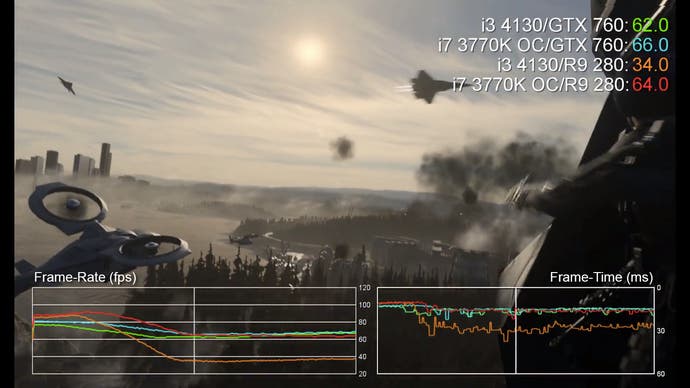
However, we can report that we see the same issue to different degrees on other AMD GPUs too, though the lower down the stack you go, the less noticeable the impact (as you're hitting GPU, rather than CPU limitations) - as we saw when testing with an R7 265, essentially an overclocked version of the classic Radeon HD 7850. Generally speaking though, if you're running anything at the R9 270 level or better, we'd recommend an Intel quad-core processor or the equivalent for best performance with an AMD card, while a Core i3 is potent enough to deal with Nvidia equivalents in this performance range.
Call of Duty: Advanced Warfare - the Digital Foundry verdict
Given more time to closely scrutinise Advanced Warfare across a breadth of stages, the tussle between PS4 and Xbox One is an easy one to summarise. Owners of Sony's latest kit enjoy a pure, true, unadulterated 1080p image throughout the game, planting its flag closest to the PC's pristine standard of presentation. The one downside for this version is its propensity for frame-rate drops in campaign mode - wavering between 50-60fps under load, and stuttering very occasionally lower. The Xbox One, meanwhile, handles this solo mode with far fewer dips, albeit with the introduction of tearing at stress points.
This does not have a bearing on its multiplayer mode, where both PS4 and Xbox One are optimised to hold 60fps at a consistency we'd expect of the series. Odd, single frames are skipped every now and then while jet-boosting around taxing stages like Instinct - but these are largely imperceptible blips on an otherwise straight 60fps line. If you only have eyes for multiplayer, either platform comfortably satisfies in the frame-rate stakes.
As a detracting point for Microsoft's platform, the resolution is often at the 1360x1080 point in campaign, only really rising to a full 1920x1080 outside of battle. This dynamic framebuffer doesn't translate as we'd expect to multiplayer either, where it's fixed to the lower number in perpetuity - resulting in a cut-off in image clarity the further into the distance you look. For us, this would be one of the bigger points of consideration, but it's not so much of an issue in the single-player campaign, owing to its more heavily post-processed image.
However, the PS4 and Xbox One each share the highest quality textures, effects and geometry of the maxed-out PC version. They only fall noticeably short in three areas; the low-grade anisotropic filtering on textures, less accurate specular mapping for reflections, and opting for SSAO, rather than the PC's subtler HBAO+ shading around objects. Otherwise, you get the full deal, complete with subsurface scattering.
Overall, the PS4's superior image quality compared with Xbox One makes it the choice pick on the multiplayer front, with both holding up here at 60fps. As for the campaign mode's playability, it's an apples and oranges contest between the Xbox One's performance lead and the PS4's resolution advantages, with little else in-between. But for those equipped to do so, the PC version is a tantalising alternative that deserves respect for putting the series back on track.








